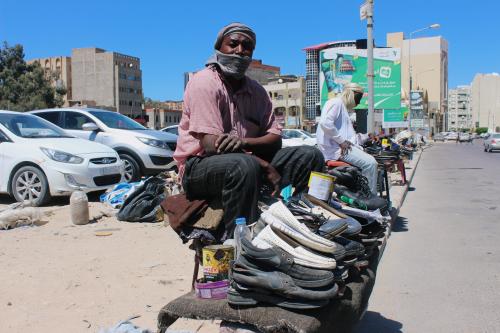Editor’s Note: Launched at a December 5, 2011 event at Brookings, this study is based on a publication developed in 2005 by the Brookings-Bern Project on Internal Displacement: Addressing Internal Displacement: A Framework for National Responsibility.
EXECUTIVE SUMMARY
It is a central tenet of international law that states bear the primary duty and responsibility to protect the fundamental rights and freedoms of persons within their borders, including the internally displaced. While internally displaced persons (IDPs) remain entitled to the full protection of rights and freedoms available to the population in general, they face vulnerabilities that nondisplaced persons do not face. Therefore, in order to ensure that IDPs are not deprived of their human rights and are treated equally with respect to nondisplaced citizens, states are obligated to provide special measures of protection and assistance to IDPs that correspond to their particular vulnerabilities. Reflecting these key notions of international law, the rights of IDPs and obligations of states are set forth in the Guiding Principles on Internal Displacement (hereafter, “the Guiding Principles”).
Using the Guiding Principles as a departure for analysis, this study examines government response to internal displacement in fifteen of the twenty countries most affected by internal displacement due to conflict, generalized violence and human rights violations: Afghanistan, the Central African Republic, Colombia, the Democratic Republic of the Congo, Georgia, Iraq, Kenya, Myanmar, Pakistan, Nepal, Sri Lanka, Sudan, Turkey, Uganda and Yemen. The analysis seeks to shed light on how and to what extent, if any, governments are fulfilling their responsibility toward IDPs, with a view to providing guidance to governments in such efforts. In so doing, this study also seeks to contribute to research and understanding regarding realization of the emerging norm of the “Responsibility to Protect.” To frame the analysis, the introduction to this volume examines the connections among the concepts of national responsibility, “sovereignty as responsibility” and the “Responsibility to Protect” (R2P).
The comparative analysis across the fifteen countries, presented in chapter 1, is based on a systematic application of the document Addressing Internal Displacement: A Framework for National Responsibility (hereafter, “Framework for National Responsibility,” “the Framework”). Seeking to distill the Guiding Principles, the Framework outlines twelve practical steps (“benchmarks”) that states can take to directly contribute to the prevention, mitigation and resolution of internal displacement:
1. Prevent displacement and minimize its adverse effects.
2. Raise national awareness of the problem.
3. Collect data on the number and conditions of IDPs.
4. Support training on the rights of IDPs.
5. Create a legal framework for upholding the rights of IDPs.
6. Develop a national policy on internal displacement.
7. Designate an institutional focal point on IDPs.
8. Support national human rights institutions to integrate internal displacement into their work.
9. Ensure the participation of IDPs in decision making.
10. Support durable solutions.
11. Allocate adequate resources to the problem.
12. Cooperate with the international community when national capacity is insufficient.
Foreword
Chaloka Beyani, Project Co-Director and UN Special Rapporteur on the Human Rights of Internally Displaced Persons commends the Project’s report for highlighting the issue that it is the government’s responsibility to protect and assist internally displaced persons who remain within their borders.
Downloads:
Executive Summary
It is a central tenet of international law that states bear the primary duty and responsibility to protect the fundamental rights and freedoms of persons within their borders, including the internally displaced. While internally displaced persons (IDPs) remain entitled to the full protection of rights and freedoms available to the population in general, they face vulnerabilities that nondisplaced persons to not face. Therefore, in order to ensure that IDPs are not deprived of their human rights and are treated equally with respect to nondisplaced citizens, states are obligated to provide special measures of protection and assistance to IDPs that correspond to their particular vulnerabilities. Reflecting these key notions of international law, the rights of IDPs and obligations of states are set forth in the Guiding Principles on Internal Displacement (hereafter, “the Guiding Principles”).
Using the Guiding Principles as a departure for analysis, this study examines government response to internal displacement in fifteen of the twenty countries most affected by internal displacement due to conflict, generalized violence and human rights violations: Afghanistan, the Central African Republic, Colombia, the Democratic Republic of the Congo, Georgia, Iraq, Kenya, Myanmar, Pakistan, Nepal, Sri Lanka, Sudan, Turkey, Uganda and Yemen. The analysis seeks to shed light on how and to what extent, if any, governments are fulfilling their responsibility toward IDPs, with a view to providing guidance to governments in such efforts. In so doing, this study also seeks to contribute to research and understanding regarding realization of the emerging norm of the “Responsibility to Protect.” To frame the analysis, the introduction to this volume examines the connections among the concepts of national responsibility, “sovereignty as responsibility” and the “Responsibility to Protect” (R2P).
The comparative analysis across the fifteen countries, presented in chapter 1, is based on a systematic application of the document Addressing Internal Displacement: A Framework for National Responsibility (hereafter, “Framework for National Responsibility,” “the Framework”). Seeking to distill the Guiding Principles, the Framework outlines twelve practical steps (“benchmarks”) that states can take to directly contribute to the prevention, mitigation and resolution of internal displacement:
- 1. Prevent displacement and minimize its adverse effects.
2. Raise national awareness of the problem.
3. Collect data on the number and conditions of IDPs.
4. Support training on the rights of IDPs.
5. Create a legal framework for upholding the rights of IDPs.
6. Develop a national policy on internal displacement.
7. Designate an institutional focal point on IDPs.
8. Support national human rights institutions to integrate internal displacement into their work.
9. Ensure the participation of IDPs in decision making.
10. Support durable solutions.
11. Allocate adequate resources to the problem.
12. Cooperate with the international community when national capacity is insufficient.
Downloads:
Introduction
At the end of 2012, there were an estimated 27.5 million internally displaced persons in more than fifty countries who had been forcibly uprooted by armed conflict, ethnic strife and other violence, a number that has increased steadily from around 17 million in 1997. Of populations at risk in the world today, the internally displaced tend to be among the most vulnerable. National responsibility is fundamental to ensuring an effective approach to internal displacement. The simple fact that IDPs remain within the borders of their own country means that it is their own state that bears primary responsibility for protecting and assisting them and for safeguarding them against arbitrary displacement in the first place.
This research project looks specifically at the ways in which governments are exercising their responsibility to address internal displacement. Using as a guide Addressing Internal Displacement: A Framework for National Responsibility, this study examines the government response to internal displacement in 15 countries, comparing those responses with the 12 benchmarks outlined in the Framework.
Downloads:
Chapter 1
Downloads:
Chapter 2 Georgia Case Study
Chapter 2 Kenya Case Study
Chapter 2 Afghanistan Case Study
Chapter 2 Sri Lanka Case Study
Chapter 3
Downloads:
Annex
Downloads:


